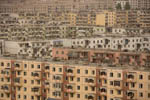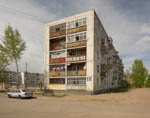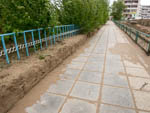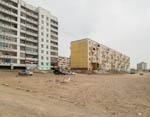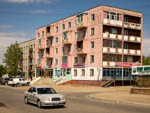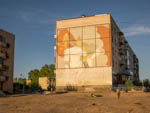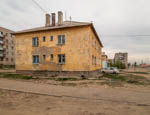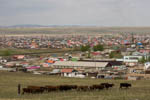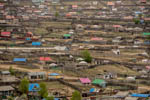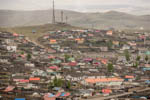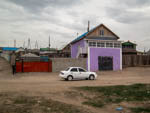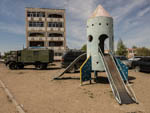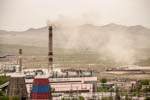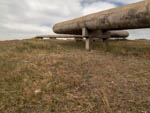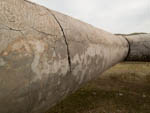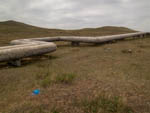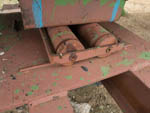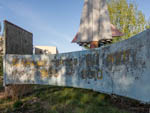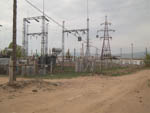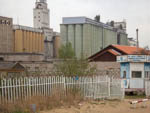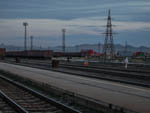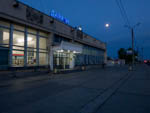From the USSR
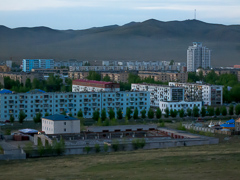
Built by the Soviets as an industrial center, it was a model city in its day. In preparing for our trip we heard over and over again that Darkhan is a city that was planned from scratch. Now that the Russians are gone its architecture is its most distinguishing visible characteristic. While it is finding its own way economically, the legacy of hundreds of old Soviet apartment buildings remain. Most are still occupied, but many appear vacant. On a clear day when most apartments have laundry hanging on the balconies, whole buildings seem deserted.
Reports on Darkhan's population vary, from 67,000 from one native, to 75,000 in Wikipedia, to 100,000 from another native. What is clear is that most of it is relatively new—started in 1961; relatively active with lots of new construction; and in the case of the huge apartments, relatively neglected, some looking like experiments to see how long they can go without paint or maintenance. And as in the rest of Mongolia there are many who simply choose not to live in apartments, living instead in the patches of ger districts that surround the city. They give up Soviet-built public hot water heat for the freedom to have their own yards where they can keep animals.
What makes Darkhan's economy possible is the trans-Mongolian railroad, another Soviet project, that allows the export of wheat and other agricultural products to the rest of the country as well as Russia and China. The railroad was started in the 1940s, and connected Russia to Ulaanbaatar in 1949. Today it connects Beijing to Moscow, as well as dozens of small towns to the larger cities.
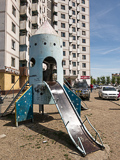 Although the Soviets have been gone for twenty years, there are still plenty of signs of their presence, even aside from their architecture. A large plaster relief of Lenin meets customers inside a new Nomins shopping center. A small steel replica of a missile, made for small children, is in a playground beneath the largest apartment in the city, with slides coming out the bottom between the fins. A larger missile replica, monument to the space race, occupies an abandoned and vandalized park next to the train station. Sculpted into the end of one of the missle's supportiing base legs are the images of two cosmonauts, one of whom is probably J. Gyrragchaa, a Mongolian who flew in the Soviet Intercosmos program in 1981 and was born near here. On one face of the base, barely visible in peeling yellow paint, is marked the span—1952-2010. It is hard to tell what this time span measures, but judging from the condition of this monument, it was the time that Mongolia was interested in space flight.
Although the Soviets have been gone for twenty years, there are still plenty of signs of their presence, even aside from their architecture. A large plaster relief of Lenin meets customers inside a new Nomins shopping center. A small steel replica of a missile, made for small children, is in a playground beneath the largest apartment in the city, with slides coming out the bottom between the fins. A larger missile replica, monument to the space race, occupies an abandoned and vandalized park next to the train station. Sculpted into the end of one of the missle's supportiing base legs are the images of two cosmonauts, one of whom is probably J. Gyrragchaa, a Mongolian who flew in the Soviet Intercosmos program in 1981 and was born near here. On one face of the base, barely visible in peeling yellow paint, is marked the span—1952-2010. It is hard to tell what this time span measures, but judging from the condition of this monument, it was the time that Mongolia was interested in space flight.
